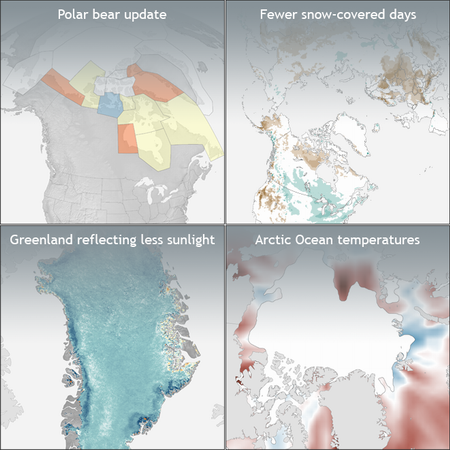
|
|

|
|
| April 20, 2024 |
|
Arctic report: Snow is down, heat is up 
SAN FRANCISCO — The Arctic continues to warm faster than the rest of the globe, and with greater repercussions, scientists are reporting.
The new findings appear in the Arctic Report Card, first published in 2006 by the National Oceanic and Atmospheric Administration and updated annually. The report card catalogs the wide-ranging changes caused by the rising temperatures, in large part driven by emissions of greenhouse gases. Snow cover, measured since 1967, was below average and set a record low in April in the Eurasian region of the Arctic. Sea surface temperatures are rising, particularly in the Chukchi Sea, northwest of Alaska, where the waters are warming at a rate of almost one degree Fahrenheit per decade. The extent of Arctic sea ice, which retreats in summer, did not hit a record low in 2014. But it was the sixth lowest since satellite measurements began in 1979, and the scientists noted that the eight smallest extents have occurred in the last eight years. “We can’t expect records every year,” Martin Jeffries of the Office of Naval Research, who edited this year’s report, said at a news conference here at the fall meeting of the American Geophysical Union. “It need not be spectacular for the Arctic to continue to be changing.” With less sea ice and more open water, sunlight entered more of the ocean, leading to a bloom of tiny marine plants. On land, the greenness of the tundra continues to increase, the report said, indicating fewer snow-covered areas. The decline in sea ice also diminished the number of polar bears in western Hudson Bay in Canada from 1987 to 2011, but populations appeared to be stable elsewhere. Polar bears rely on sea ice to travel and hunt. In Greenland, scientists observed that melting occurred on almost 40 percent of the ice sheet during the summer, and in August, the ice sheet reflected less of the sunlight than at any time since the beginning of satellite observations in 2000. In a separate news conference, scientists reported that NASA satellite measurements have confirmed that a darker, less reflective Arctic absorbs more heat and accelerates melting. (Source: New York Times) Story Date: December 22, 2014
|